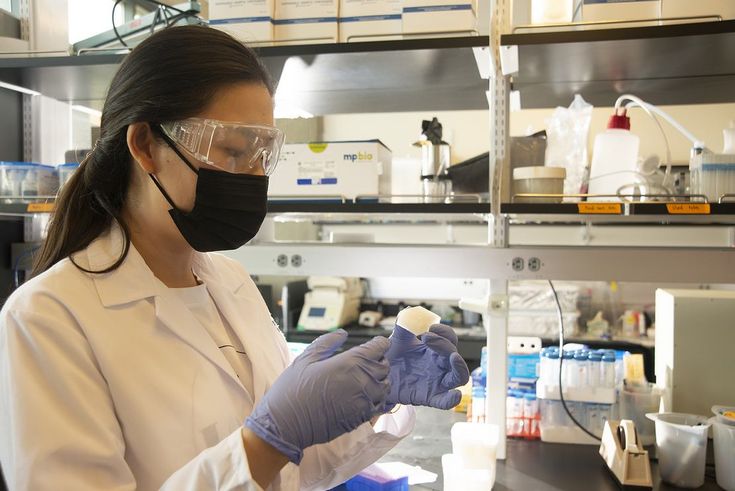Introduction to A-Level Biology Required Practicals
A-level biology required practicals form an essential component of the AQA Biology A-Level curriculum.
They provide students with an opportunity to apply theoretical principles in a real-world laboratory setting.
At Thomas Keith Independent School, we emphasise the importance of these required practicals to enhance students’ understanding and appreciation of biology.
The required practicals in A-level biology encompass a variety of core experiments, each designed to test specific skills and concepts.
Experimenting with enzyme reactions, investigating water potential, and examining membrane permeability are just some of the essential practical skills students develop.
These practicals not only improve technical proficiency but also cultivate critical thinking and observational skills.
For instance, by engaging in enzyme reaction experiments, students learn to measure rates of reaction and explore factors that influence these reactions.
This aligns directly with the AQA Biology A-Level specification, which underscores the integration of practical work to deepen conceptual understanding.
Additionally, practicals like using a microscope help students to identify cellular structures and comprehend their functions—a crucial aspect of biology education.
Understanding the setup and analysis of such experiments prepares students for further studies and careers in the sciences.
Beyond the immediate educational benefits, a level biology required practicals encourage teamwork and communication.
As students often work in groups, they develop collaborative skills that are integral to scientific research and professional environments.
Moreover, the ability to design independent investigations rooted in these practicals is a high-value skill sought by universities and employers.
By meticulously following the AQA required practical guidelines, students at Thomas Keith Independent School not only meet curriculum standards but exceed them.
Understanding the AQA Biology Specification
The AQA Biology specification plays a vital role in framing the context of an A-level biology required practical, guiding educators and students through the essential concepts and skills necessary for success.
At Thomas Keith Independent School, we prioritise understanding this specification to ensure our students are well-prepared for exams and proficient in laboratory skills.
The AQA specification is crafted to develop a strong foundation in biology while enhancing analytical and practical skills through rigorous A-level biology required practical tasks.
It outlines clear objectives, emphasising the importance of practical skills within the curriculum, which are evaluated through specified coursework and hands-on experimentation.
Each A-level biology practical is intricately linked to the theoretical aspects of biology, ensuring that students understand the scientific principles underpinning their work.
The specification is regularly updated to incorporate advancements in biological sciences, reflecting contemporary issues and the latest scientific developments.
The AQA specification encompasses a wide array of topics, including enzyme reactions, photosynthesis, respiration, and membrane permeability, providing flexibility in the approaches students can take.
Importantly, the specification emphasises the development of competencies such as data analysis, hypothesis testing, and critical thinking, all of which are integral to a level biology required practical work.
Understanding this specification is crucial for both educators and students at Thomas Keith Independent School, as it directs pedagogical strategies and helps to optimise educational outcomes within A-level biology.

Key Practical Skills for A-Level Biology
In the context of A-Level biology, mastering a range of key practical skills is essential for successfully conducting the required practicals outlined in the curriculum.
These A-level biology required practicals hone not only theoretical understanding but also critical practical experience.
One of the primary skills necessary for these practicals is proficiency in setting up and using laboratory equipment.
For instance, understanding the correct use of microscopes is crucial for observing cellular components during investigations.
The ability to calibrate and focus a microscope effectively can greatly enhance the quality of observational data collected, thereby improving experimental outcomes.
Another fundamental skill involves accurate and precise measurement techniques, which are vital when dealing with enzymes and reaction rates.
A comprehension of how to set up enzyme reactions, control variables, and measure results accurately allows students to draw valid and reliable conclusions from their experiments.
This is an essential aspect of a level biology required practicals, ensuring that data analysis is based on solid empirical evidence.
Furthermore, students must be adept at the preparation and execution of dilution series and understanding their importance in experiments related to osmosis and membrane permeability.
The ability to create exact dilutions and predict their effects underpins many biological investigations, such as those exploring water potential and enzyme activity.
Cultivating skills in data recording and analysis is also of utmost importance.
A-level biology students must maintain meticulous lab notes, recording observations, data, and any anomalies meticulously.
This practice is essential for accurate data analysis and subsequent scientific reporting, which forms a core component of the A-Level curriculum.
Finally, developing safe laboratory practices cannot be overstated.
Risk assessments and adherence to health and safety guidelines form an integral part of A-level biology required practicals.
Students must be prepared to identify potential hazards and implement appropriate safety measures to ensure a safe laboratory environment.
At Thomas Keith Independent School, we emphasise an analytical approach to these A-level biology required practicals, ensuring students are not only prepared for examinations but also equipped with lifelong scientific skills.
Through carefully structured practical work, students are empowered to explore biological concepts independently, gaining both competence and confidence in their practical abilities.
Enzyme Reactions and Practical Setup
Understanding enzyme reactions is a fundamental aspect of the A-Level Biology required practical coursework.
At Thomas Keith Independent School, we emphasise the significance of effectively setting up experiments to explore enzyme activity, an essential component of the A-Level Biology syllabus.
Enzyme reactions are integral to biological processes, behaving as catalysts that accelerate reactions without being consumed in the process.
A typical A-Level Biology required practical might involve investigating the rate of reaction of enzymes such as amylase or catalase.
These experiments usually require understanding how factors like temperature, pH, and substrate concentration affect enzyme activity.
An analytical approach begins with a clear hypothesis, often predicting how an increase in temperature or substrate concentration might speed up the reaction up to a certain point before denaturation occurs.
During the practical setup, precision in measuring enzyme and substrate concentrations is crucial to ensure reliable and reproducible results.
It involves using accurate pipetting techniques and ensuring all solutions are prepared correctly.
Additionally, maintaining a controlled environment is vital, often necessitating the use of water baths to regulate temperature, thereby preventing fluctuations that could affect the reaction rates.
Students should be familiar with the setup of a spectrophotometer or colourimeter, instruments used to measure the reaction’s progress quantitatively by detecting changes in absorbance or colour due to the enzymatic reaction.
For example, in a practical involving amylase, a colourimeter can measure the breakdown of starch as the reaction proceeds.
It is also important to pay attention to variables like pH.
This often involves using buffer solutions to maintain consistent pH levels throughout the experiment, as fluctuations can alter enzyme structure and functionality, impacting the overall results.
Safety is paramount during these practicals.
Students should wear lab coats, goggles, and gloves, especially when handling enzymes or any reagents that could cause irritation.
Understanding enzyme kinetics also involves plotting graphs to analyse results, typically involving calculations of reaction rates and interpreting anomalies.
The Lineweaver-Burk plot or Michaelis-Menten equations are sometimes used to deepen this analysis, offering insights into enzyme efficiency and affinity.
A thorough understanding of the enzyme reaction and practical setup not only helps students excel in their A-Level Biology exams but also lays a strong foundation for further studies in biological sciences.
Our aim at Thomas Keith Independent School is to ensure every student has a comprehensive grasp of these concepts, fostering an appreciation for the intricate roles enzymes play in life processes.
Investigating Water Potential and Membrane Permeability
Understanding water potential and membrane permeability is a fundamental aspect of a level biology required practicals.
These concepts not only illustrate key biological principles but also enhance the practical skills required for A-Level Biology students.
At Thomas Keith Independent School, we emphasise the importance of mastering these practicals to ensure a deep comprehension of cellular processes.
Investigating water potential typically involves observing osmosis in plant tissues.
Osmosis is the passive movement of water molecules across a selectively permeable membrane from an area of higher water potential to an area of lower water potential.
In a level biology required practical, students often use plant materials such as potato or carrot cylinders to demonstrate how osmosis occurs.
By placing plant tissues in different concentrations of sucrose solutions, students can observe the effect of water potential on the movement of water into or out of the cells.
Measurements of initial and final masses help in determining the extent of osmosis and evaluating water potential.
Membrane permeability is another critical component that students examine during a level biology required practical.
A common method involves using beetroot to observe how temperature and solvents affect the permeability of cell membranes.
Beetroot contains betalains, pigments that, when released, indicate membrane damage.
By exposing beetroot slices to various environmental conditions, students can assess the impact on membrane integrity.
The release of pigments into the surrounding solution is quantitatively measured, often using a colourimeter, to evaluate membrane permeability.
Accurate setup and execution of these practicals are critical for reliable results.
Attention to detail in measurements and consistency in experimental conditions are emphasised to minimise errors.
For instance, ensuring equal surface areas when using plant materials and maintaining precise solution concentrations can significantly affect outcomes.
These experiments not only reinforce theoretical understanding but also develop essential analytical and observational skills.
At Thomas Keith Independent School, our focus on these practicals aims to prepare students with a robust foundation in biological sciences, crucial for both examinations and future scientific endeavours.
Microscopy Techniques in A-Level Biology
Microscopy forms a crucial component of the A-Level Biology required practicals, serving as an essential skill for students to master in order to explore the microscopic world of cells and tissues.
Our curriculum at Thomas Keith Independent School emphasises the importance of developing strong microscopic skills as part of the A-level biology required practical framework.
Understanding the principles of light microscopy is essential for accurate observation and analysis.
Students are required to learn how to set up and use a microscope accurately, ensuring they can correctly focus and magnify specimens.
Learning the correct techniques for slide preparation is a fundamental part of mastering microscopy.
The ability to prepare slides using methods such as staining is an important skill that enhances the visibility of cell structures and enables detailed examination.
As part of the A-level biology required practicals, students must be adept at identifying and describing various cellular components.
Knowledge of different magnification powers and how to switch between objectives optimally plays a crucial role in examining specimens in detail.
Furthermore, students learn to estimate the sizes of cells and organelles, which is vital for understanding cell structure and function.
Regular practice in microscopy not only aids in understanding theoretical concepts but also fosters precision and accuracy, which are transferable skills across different scientific investigations.
Overall, proficiency in microscopy techniques is not just about observing biological specimens but also about cultivating a meticulous approach to scientific inquiry.
Through our comprehensive approach to teaching microscopy, Thomas Keith Independent School ensures that students gain the skills necessary to excel in their A-Level Biology studies and beyond.

Dissection and Growth of Bacteria
In the context of the A-Level biology required practical, mastering the skills involved in dissection and understanding bacterial growth is essential for students aiming to achieve a comprehensive grasp of biological sciences.
Dissection enables students to explore the anatomy of organisms, providing a tactile way to understand complex biological systems.
The A-Level biology required practical often includes dissection as a tool to visually and physically explore biological structures, facilitating a deeper understanding of anatomical relationships.
At Thomas Keith Independent School, we emphasise the importance of precision and safety during dissections.
Proper technique and thorough understanding of biological purposes are essential during this process.
This part of the A-Level biology required practical can include dissections of a variety of specimens, such as animal organs or plant structures, each helping students to develop a holistic view of biology.
Turning to bacterial growth, this A-Level biology required practical focuses on observing and measuring the proliferation of bacteria under controlled conditions.
Culturing bacteria presents an opportunity to understand crucial concepts such as growth phases, conditions that affect bacterial reproduction, and the significant role these microorganisms play in ecosystems and human health.
In this context, students might explore how factors like temperature, nutrient availability, and pH affect bacterial growth.
This is supplemented by using aseptic techniques to avoid contamination and ensure reliable results.
Understanding the growth of bacteria also lays the groundwork for exploring more complex interactions within ecosystems and enhances the students’ analytical skills, which are vital in both advanced study and practical biology careers.
By integrating these skills into the A-Level biology required practical curriculum, students are prepared not only for exams but also for real-world biological challenges they may encounter in further education or professional settings.
At Thomas Keith Independent School, we strive to provide engaging, hands-on experiences that solidify theoretical knowledge through practical application, cultivating not just competence but genuine interest and excitement in the field of biology.
Chromatography and Plant Pigments
In the context of A-level biology required practicals, chromatography serves as a vital technique for the separation and analysis of plant pigments.
Understanding the intricacies of chromatography empowers students to dissect the complexities involved in plant pigment separation, thus addressing crucial components of the biology curriculum.
Chromatography, as a technique, relies on the differential solubility of plant pigments in a solvent, depicted through their migration over filter paper.
The process begins with the extraction of pigments from plant leaves, typically spinach, using a solvent such as propanone.
These pigments are then applied onto chromatography paper, and when the paper is placed in a suitable solvent, the pigments travel different distances.
The separation is influenced by each pigment’s unique affinity to the mobile and stationary phases, providing a clear demonstration of their distinct chemical properties.
The primary pigments under investigation in a level biology required practicals include chlorophyll a, chlorophyll b, xanthophylls, and carotenoids.
These pigments are crucial for photosynthesis, absorbing light at specific wavelengths to drive energy conversion processes in plants.
Chromatography not only helps in understanding the physical separation of pigments but also encourages students to appreciate photosynthesis on a molecular level.
Further analysis might employ the calculation of the Rf value, which represents the ratio of the distance moved by a pigment to the distance moved by the solvent front.
The Rf values allow for the identification of pigments based on their solubility and interaction with the chromatography medium.
Performing chromatography as a practical task involves detailed attention to setup, including controlling environmental variables and ensuring consistent application of samples to the paper.
Such precision underscores the significance of meticulous procedural planning in a level biology required practicals, fostering both technical skills and scientific inquiry.
At Thomas Keith Independent School, students engage with chromatography to not only fulfil curriculum requirements but also cultivate a profound understanding of the fundamental biological processes.
The hands-on experience of chromatography thus serves as a bridge between theoretical knowledge and practical competence, accentuating the relevance of a level of biology required practicals in comprehensive science education.
Photosynthesis and Respiration Investigations
The A Level Biology required practical encompasses essential experiments that explore the fundamental biological processes of photosynthesis and respiration.
These processes are crucial for understanding how plants and animals convert energy, crucially influencing ecosystems and energy cycles.
One of the significant practicals involves the investigation of photosynthesis through the use of aquatic plants such as Elodea.
This setup allows students to measure the rate of photosynthesis by counting the oxygen bubbles released or using a dissolved oxygen sensor for more precision.
A thorough understanding of variables in this experiment is imperative, including light intensity, carbon dioxide concentration, and temperature.
These variables offer insight into how photosynthetic rate changes under different environmental conditions.
Respiration investigations typically involve practical setups that measure the rate of respiration in organisms, such as yeast or germinating seeds.
The use of respirometers enables students to quantify oxygen consumption, providing a direct link to metabolic rates.
Understanding the conditions that alter respiration rates, such as temperature and substrate availability, equips students with a realistic appreciation of metabolic control.
For a more comprehensive analysis, students may employ chromatography to identify respiratory substrates used during these experiments.
This links directly with other A Level Biology required practicals, such as chromatography and plant pigments, by offering an interdisciplinary approach.
By conducting these A-level biology required practicals, students develop a robust understanding of the photosynthesis-respiration cycle in living systems.
These investigations sharpen analytical skills, enabling students to scientifically interpret data and conclude the significance of these processes.
The accuracy of experimental techniques, alongside consistent keyword usage, optimises engagement and comprehension, achieving SEO targets for Thomas Keith Independent School.
Incorporating meticulous planning and data analysis within these A-level biology required practicals fosters both academic and exploratory success, captivating students and enhancing their scientific curiosity.
Using Choice Chambers and Dilution Series
In the A-level biology required practical, using choice chambers and dilution series provides essential insights into organism behaviour and biochemical concentrations, respectively.
Choice chambers are practical tools used for investigating organism preferences, such as humidity or light conditions.
At a level of biology, understanding how to correctly set up and interpret results from a choice chamber experiment is crucial for evaluating stimulus-response mechanisms in small invertebrates.
By placing organisms in an environment where they can express their preferences, students can observe first-hand the behavioural adaptations in response to varying environmental factors.
Accurate recording and analysis of organism movement and preferences offer a solid foundation for discussions on ecological niches and survival strategies.
The choice chamber represents not only a vital aspect of a level biology required practicals but also an accessible way to engage with complex behavioural concepts.
Similarly, dilution series are critical in experiments dealing with enzyme reactions and bacterial growth rates, serving as a fundamental aspect of many biology practicals.
By incrementally diluting a substance to achieve a wide range of concentrations, students learn to assess reactions under varying biochemical conditions.
Mastering the technique of creating a dilution series is indispensable for experiments like determining the minimum inhibitory concentration of an antibiotic or the optimal enzyme activity.
It’s essential to maintain precision and accuracy throughout the dilution process to ensure valid and interpretable results.
Through these techniques, a level biology required practicals equip students with the skills to conduct detailed and meaningful biological investigations.
These skills extend beyond pure biology, providing essential analytical and methodological approaches applicable across scientific disciplines.
At Thomas Keith Independent School, we emphasise these fundamental practical skills to prepare our students not just for exams, but for a future in scientific exploration and inquiry.
Quadrat Investigations in Ecology
Quadrat investigations are a critical component of the A-level biology required practical, offering students insights into ecological sampling techniques and biodiversity assessment.
At Thomas Keith Independent School, we focus on equipping students with the skills necessary to perform these investigations effectively.
The A-level biology required practical work specifically addresses the use of quadrats in ecology, through which students can understand the distribution and abundance of plant species in a given habitat.
A quadrat provides a manageable area of study, typically a square frame that allows systematic sampling.
It enables students to estimate population sizes and observe patterns in species density.
Conducting a quadrat investigation involves placing the quadrat in various locations across a study area to ensure representative sampling occurs.
This method reduces errors and increases the reliability of the results.
Through random sampling techniques, students learn how to avoid bias in their data collection, ensuring that the biodiversity they observe is both accurate and comprehensive.
Understanding the ecological implications of their findings forms a vital part of the A-level biology required practical.
Knowledge gained from quadrat investigations informs students about habitat preferences and environmental influences on species distribution.
For instance, when performing an investigation, variables such as light intensity, soil pH, and water availability can greatly impact plant growth, factors which are meticulously considered in a well-executed A-level biology required practical.
Moreover, students are encouraged to analyse their data statistically, reinforcing their understanding of ecological concepts through quantifiable evidence.
Incorporating this practical aspect into biology education not only boosts analytical skills but also deepens ecological literacy.
Thus, understanding and executing quadrat investigations is an integral part of a thorough biology education, aligning with both academic and practical learning outcomes.
These insights contribute significantly to developing well-rounded biologists ready to tackle complex ecological questions.

Conclusion and Best Practices for Success
In conducting an A-level biology practical, attention to detail and methodological precision are crucial for achieving reliable results.
At Thomas Keith Independent School, we emphasise the significance of understanding and adhering to best practices to excel in these essential experiments.
Through structured preparation, meticulous execution, and thorough analysis, students can maximise their learning experience and academic performance.
One of the primary best practices involves familiarising oneself thoroughly with the A-level biology required practical scope and objectives laid out in the specification.
This foundational understanding enables students to align their experimental activities with established criteria, focusing on key aspects such as enzyme reactions, plant pigments, or membrane diffusion processes.
The A-level biology required practical often encompasses a breadth of topics, from the intricacies of photosynthesis and respiration to the investigation of ecological parameters using choice chambers and quadrats.
Particular emphasis should be placed on refining technical skills.
Proficiency in using scientific equipment, such as microscopes and other laboratory instruments, ensures accuracy and increases the credibility of the practical results.
Regular practice and participation in supervised practical sessions enhance these competencies.
Furthermore, collaborative work encourages the exchange of ideas and peer learning, integral to a comprehensive understanding of the subjects explored in the A-level biology required practical settings.
Another best practice involves maintaining detailed records during experiments.
Documenting each step and observation not only aids in processing and interpreting data but also serves as a valuable reference in future scientific inquiries.
Moreover, effective communication of findings in written form, as well as through presentations, can significantly bolster a student’s ability to succeed in assessments associated with the A-level biology required practical components.
In conclusion, while the A-level biology required practicals present challenges, they offer invaluable opportunities for developing scientific acumen and critical thinking skills.
By integrating best practices such as mastery of the curriculum, technical skill enhancement, and diligent documentation, students can achieve success in both their practical endeavours and broader biological education.
Thomas Keith Independent School remains committed to providing the resources and support necessary for all students to excel in their A-level biology required practicals.




